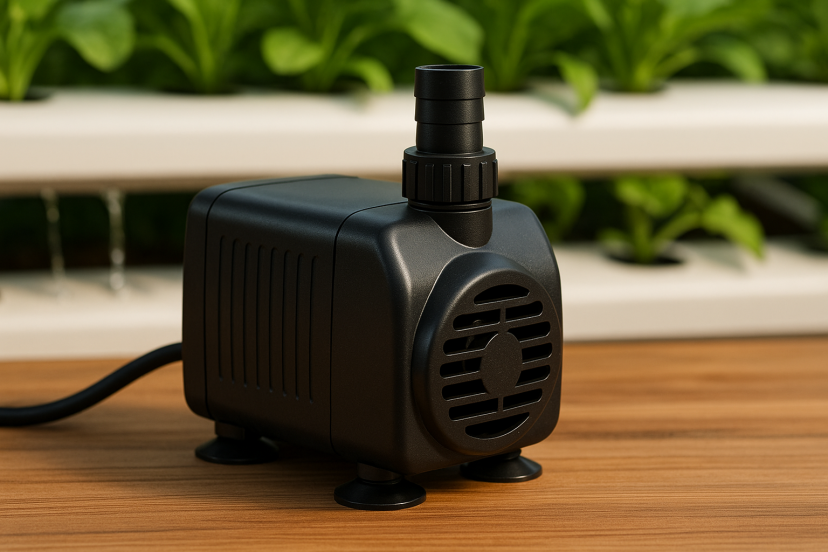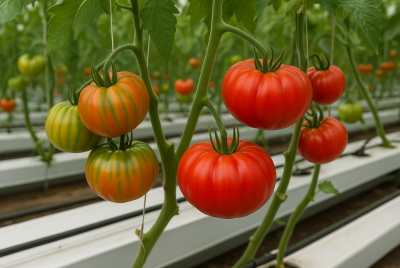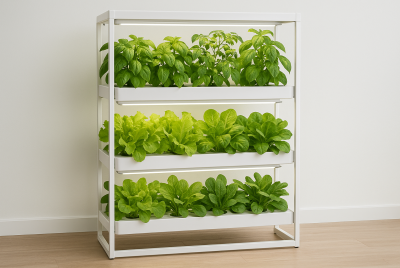Hydroponics Pump: Best Picks for Healthy Plant Growth
We may earn a commission for purchases made using our links. Please see our disclosure for more details.
If you’ve tried hydroponic gardening, you know how exciting it is to see plants grow without soil. But here’s the fact: even with strong lights and quality nutrients, your system won’t work without a reliable hydroponics pump. The pump is the heart of the garden. It pushes nutrient-rich water to the roots and keeps your plants alive. Many growers overlook this. They buy a cheap or small pump and soon their plants start to wilt from weak water flow. I’ve had the same problem. My lettuce leaves drooped because the pump couldn’t keep up.The good news is that choosing the right pump is simple. Once you have it, your plants will reward you with faster growth and better harvests.
Why a Hydroponics Pump Matters
Hydroponics relies on water circulation. Unlike soil, where roots can search for nutrients, hydroponic plants depend entirely on consistent delivery. A pump ensures:
- Even distribution of nutrients to every root zone.
- Steady oxygenation in systems like DWC.
- Healthy circulation to prevent stagnant water and root rot.
One study in Frontiers in Plant Science (2020) found that lettuce grown with optimized water flow achieved a 27% higher yield compared to systems with irregular pumping. That’s a big difference for something as simple as steady circulation.
When I first upgraded my own small NFT system to a better pump, I noticed the change within days. The roots looked whiter, and growth took off. Pumps might seem like small equipment, but they have a massive impact on results.
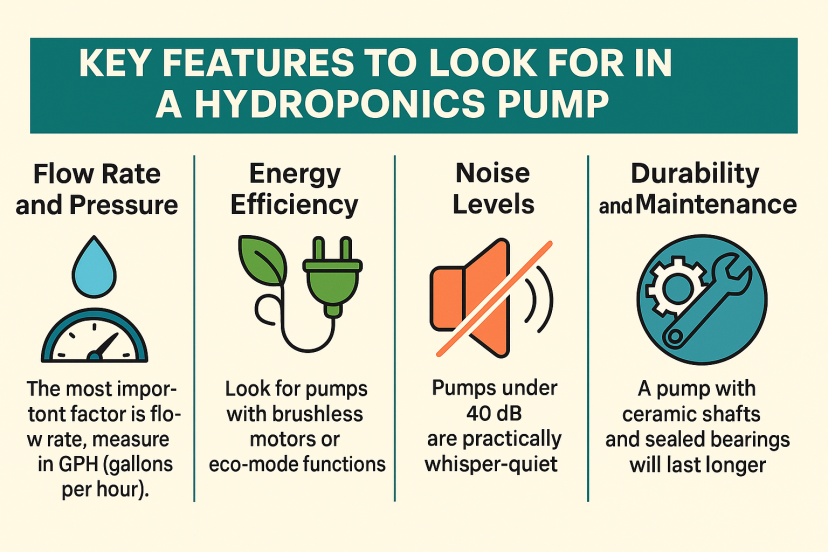
Key Features to Look For in a Hydroponics Pump
Not all pumps are created equal. Here’s what to check before you buy:
Flow Rate and Pressure
The most important factor is flow rate, measured in GPH (gallons per hour). A small indoor NFT setup may only need 200–400 GPH, while a large drip system might require 800–1000 GPH. Always choose a slightly stronger pump than you think you need—it’s better to adjust down than fall short.
Energy Efficiency
Your pump uses a lot of energy because it runs nearly all the time. Look for pumps with brushless motors or eco-mode functions. Many growers report saving a noticeable amount on electricity with efficient models.
Noise Levels
If your garden is in a bedroom, office, or small apartment, noise becomes a dealbreaker. Pumps under 40 dB are practically whisper-quiet. Trust me, nothing ruins the joy of indoor gardening like a constant mechanical hum.
Durability and Maintenance
A pump with ceramic shafts, sealed bearings, and corrosion-resistant materials will last longer in nutrient-rich solutions. Also, make sure the design allows for easy cleaning—hydroponic water can get gunky fast.
5 Best Hydroponics Pump Recommendations
Here are five top-rated pumps hydroponics growers love. Each is well-suited for indoor systems and balances reliability with value:
1. VIVOSUN 800 GPH Submersible Pump – This pump is a favorite for medium to large hydroponic systems. With strong water flow and durable construction, it keeps nutrient solutions circulating smoothly.
2. GROWNEER 550 GPH Submersible Pump – An excellent balance between power and efficiency. Ideal for growers who want steady flow without high energy use.
3. Simple Deluxe 1056 GPH Ultra Quiet Pump – If you’re running a larger system, this pump delivers serious capacity while keeping noise low.
4. VIVOSUN 400 GPH Submersible Pump – A solid mid-range option. Compact and efficient, it works well for small hydroponic gardens or grow tents.
5. PULACO 400 GPH Submersible Pump – Budget-friendly yet reliable, this pump is great for beginners or small setups.
💡 Tip: If you’re running multiple small systems, sometimes it’s smarter to buy two smaller pumps rather than one oversized unit. That way, if one fails, your whole garden doesn’t collapse. For best results, also learn how to clean and sterilize your hydroponic system.
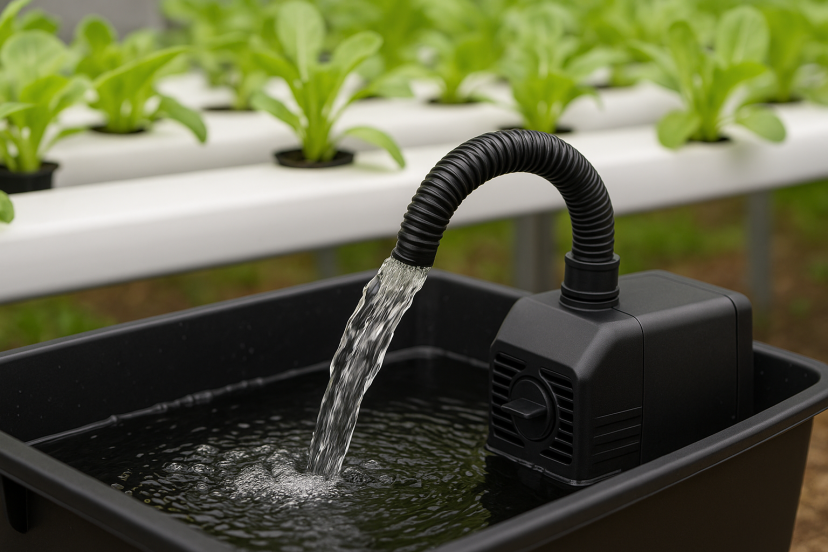
What Experts and Studies Say
Hydroponics researchers stress the importance of pumps. Dr. Kevin Li from Wageningen University once said, “Your pump is the heart of the system—if it fails, your plants fail.”
User reviews back this up. Many growers admit that their biggest mistakes came from underestimating pumps. Some tried aquarium pumps, only to find they burned out quickly under continuous use. Others bought high-flow pumps without considering noise, leading to frustration when placed in a bedroom grow tent.
A robust body of research underscores this point. For instance, the Effectiveness of Water and Air Pumps on Lettuce Growth study found that using a water pump significantly boosted plant height, leaf number, and fresh weight compared to systems without one.
Another important paper, Water Circulation and Control of Hydroponics Using IoT, highlighted how nutrient solution flow directly impacts growth in NFT systems, proving that optimized circulation is essential for nutrient uptake and plant performance.
These findings confirm that pumps don’t just move water—they actively improve plant vitality and yields.
Choosing the Right Pump for Your Setup
Different systems call for different pump strengths:
- NFT Systems: Moderate, consistent flow (200–400 GPH).
- DWC Systems: Pumps paired with air stones improve root oxygenation.
- Drip Systems: Higher-capacity pumps (600–1000 GPH) to feed multiple lines.
- Aeroponics Systems: Require strong, reliable pressure for fine misting.
From personal experience, I recommend slightly oversizing your pump. I once ran a 600 GPH pump in a system that technically only needed 400 GPH. The result? Stronger nutrient delivery and more peace of mind knowing the pump wasn’t operating at max capacity all the time.
Common Mistakes When Buying a Hydroponics Pump
Even experienced growers slip up. Here are the pitfalls to avoid:
- Undersizing the pump: Leads to weak water flow and plant stress.
- Oversizing too much: Wastes power and creates turbulence.
- Ignoring noise: A constant hum can become unbearable indoors.
- Skipping warranties: Pumps run nonstop—coverage is worth it.
- Neglecting maintenance: A clogged impeller can kill performance.
Pro tip: Always have a backup pump handy. Nothing is worse than losing an entire crop because a pump failed at midnight on a Saturday.
Conclusion
A hydroponics pump might not look exciting, but it’s the most important piece of your setup. Think of it as insurance for your harvest. A reliable pump keeps nutrients moving, oxygen flowing, and roots healthy. By choosing wisely—balancing flow rate, efficiency, noise, and durability—you’ll avoid headaches and enjoy healthier, faster-growing plants. If you’re serious about yields, don’t cut corners on the pump. Instead, invest in a model that matches your system’s needs and supports your garden for seasons to come.
FAQs
1. What is the required size of a hydroponics pump?
Small NFT setups need 200–400 GPH, while larger drip or DWC systems often require 600–1000 GPH.
2. How often should I replace my hydroponics pump?
With proper cleaning, most pumps last 2–3 years. Some premium models go longer.
3. Can I use an aquarium pump for hydroponics?
For very small systems, yes. But hydroponics pumps are built for continuous operation, making them a better long-term choice.
4. What’s the quietest hydroponics pump?
Models under 40 dB, like the EcoPlus 396 or Simple Deluxe, are best for indoor growing spaces.
5. Do pumps used in hydroponics consume a lot of power?
Not really. Energy-efficient pumps often consume less power than a single LED light bulb.

